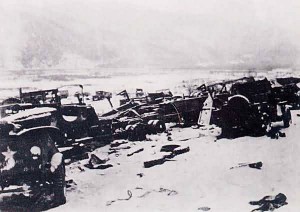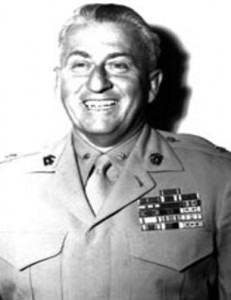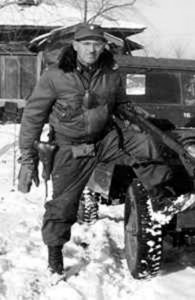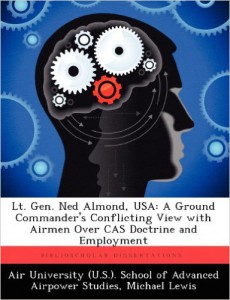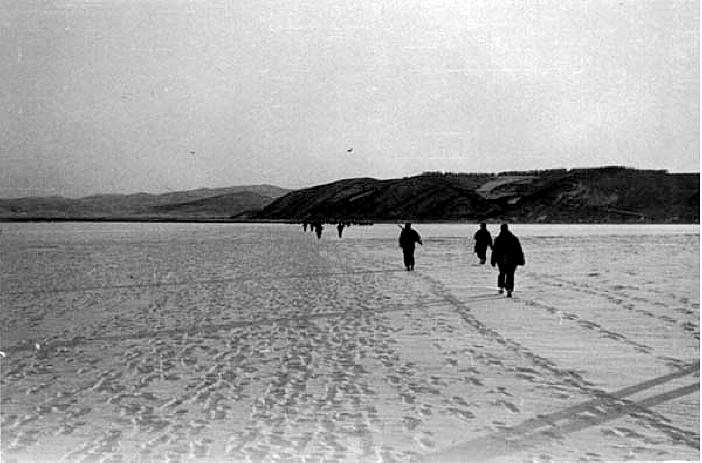 Survivors crossing the ice to Hagaru-ri
Survivors crossing the ice to Hagaru-ri “It is nothing; for this are we soldiers.” -Colonel Guy V. Henry-, severely wounded on the battlefield at Rosebud Creek, June 1876.
Part I, Part II, Part III of BOTH SIDES OF THE CHOSIN series.
Faith decided that on December 1st that he would attempt to take his force back the way that they came and at the base of the reservoir move to the perimeter of Hagaru-ri. Unknown to him, the Army tanks at Hudong had been ordered to Hagaru by the 7th Division commander the night before. While there were good reasons (including shortage of main gun and .50 caliber ammunition) the result would make a desperate action even more so.
Meanwhile the regiments at Yudam-ni were fighting their way down the MSR. The placement of Fox Company at the Toktong pass proved fortuitous…had the Chinese held it the breakout would have failed. From there it was breaking through roadblocks and ambushes. It would take more days, but they would reach Hagaru.
Seventh Division flag officers and staff relocated and Almond placed Task Force Faith under General Smith before Barr and others flew out by chopper. Might as well have placed them under the C.O. at Fort Dix New Jersey. Smith attempted to broadcast an order for the task force to attempt to reach Hagaru. They didn’t get the order, but in any event Faith had already decided to do just that.
More than half his men had wounds of some type and ammunition of all calibers was running low. The artillery was ordered to have its howitzers fire all remaining stocks and then destroy them.
Trucks that could still run were emptied of everything so that the wounded could ride out. Everything else was ordered destroyed. On the morning of December 1, 1950, Task Force Faith started to move. There were problems from the start.
Faith’s own battalion started to move, but somehow the other one didn’t get the start time. Fortunately it saw and moved. Faith was running on courage and nerve… not everything went according to plan… starting with some supplies that were not burned (air strikes the next day dealt with that problem.)
Marine and Navy aircraft went for the Chinese (half of all Marine air used in the Reservoir area went to Army or South Korean units…) A company sized roadblock had to be taken out… One napalm canister landed so as to take it out… but some casualties were inflicted on soldiers of the lead platoons who were close. This took some of the steam out of the movement… This was bad since so many of the casualties of previous days had been some of the best officers and NCOs. Faith was leading from the front and this inspired the men who were near him.
Soldiers designated to protect the trucks often sought shelter below the gravel road as they moved…which too often blocked their view of enemy weapons. Progress was agonizingly slow as drivers were hit and had to be replaced…soon volunteers were hard to find. Wounded were layered in the back of the trucks and many were hit repeatedly by enemy fire. Some wounded were trapped under piles of dead.
When the column at last got to Hill 1221 (one of two places where at least a platoon should have been left), they found a battalion of Chinese occupying the hill…and they had set up a roadblock on the road below.
Faith personally led an assault on the roadblock and was badly wounded. By this point the light was fading and air support had to withdraw. The immobile trucks continued to be struck by enemy fire. The rear guard closed up with the column and kept moving. The rear was no longer guarded. The majority of officers were dead.
Soldiers assaulting the hill punched holes in the enemy lines…but then kept going…out onto the ice and towards Hagaru some miles away. At last the roadblock was removed but a switchback was reached where a small bridge had been blown. The truck tires could not get traction and an AA carrier (by now out of ammunition) which was on tracks had to painfully assist each wheeled vehicle.
Just north of Hudong the Chinese had a powerful roadblock. Lt. Colonel Faith was killed almost immediately and what was left of Task Force Faith was no longer a coherent unit. The trucks could move no farther. Any wounded who could get out did and headed for the ice.
Some Chinese soldiers attempted to remove wounded from the trucks but others simply tossed in white phosphorus grenades. Almond’s “laundrymen” were made of sterner stuff than he had claimed.
Two officers tried to organize a “rump” outfit… a Major Storms who was the last assigned commander of 3/31 and a fine officer… and Captain Stamford who had destroyed his comm gear at full dark as there would be no chance to use it again. Storms was soon killed and Stamford found soldiers gravitating towards him. They tried to break through but were captured.
Here it gets a little strange to those not familiar with Chinese Communist Forces and their SOP during the Chinese civil war. Fighting Japanese it was of course war to the knife, but Nationalist Chinese were often disarmed and allowed to go… troops without weapons were often allowed to leave.
The idea was that they would return to their own forces and the story would spread and in later actions the Nationalist Chinese soldiers would not be inclined to fight to the death. Castro’s Cuban revolutionaries did the same in their guerrilla campaign in the mountains. Not all Chinese units in late 1950 acted this way, but their 27th Corps, which is who Task Force Faith was in contact with often did until after that campaign.
Some soldiers had fought clear. Others had fired the last of their ammo and dropped their rifles as they fled… and some Chinese ignored them. Others were disarmed and allowed to leave… Some units made a point of taking and keeping prisoners. Stamford and a handful of soldiers were able to give their Chinese guards the slip in a snowstorm.
Two issues that need to be looked at. Why…in such ungodly cold did the task force not simply attempt to drive across the ice? The Soviets at Leningrad ran rails and trains across the ice during the German siege. But Soviet engineers knew all that there was to know about Lake Ladoga. The Americans knew little about the Chosin Reservoir.
In the coldest parts of Siberia, for various reasons, ice does not form in certain parts of otherwise frozen lakes. Other factors can cause thin ice in various parts of a lake that is frozen solid. The risk, with wounded in all the trucks would have been great. But even in extremis it should be remembered that most trucks belonging to Task Force MacLean/Faith had no chains.
The other issue deals with the wounded. Even if the tanks and support troops had remained at Hudong, it is unlikely in the extreme that the force could have fought its way out intact carrying its wounded. The Marines got theirs out for many reasons…the biggest being that the largest mass of wounded were flown out from Hagaru starting on December 1st and the columns blasting through the Chinese did not start out with overwhelming numbers of casualties.
From the moment that the task force took up “jump-off” positions for a move to the north…and had not left forces on the two most threatening potential checkpoints along their line of retreat…the command had little chance to get out intact…and none after the first night.
At Arnhem in WWII the British 1st Airborne Division managed to get thousands of survivors across the Rhine and to safety. To do that they had to leave countless wounded soldiers to the “clemency of the enemy…” The result was something that the Allies could live with.
But experience with the Japanese and the North Koreans had been ghastly. The Americans simply would not leave their wounded to an Asian enemy. Through no fault of its own the task force was destined to be shattered.
ICE TO HAGARU
Lieutenant Harold Myers had been in one of the trucks. He managed to get out before the Chinese started burning them. Some Chinese were attempting to help the wounded…others were bayoneting them. Myers made it onto the ice and after a time could only crawl. A Marine patrol scooped him up.
As the first survivors approached Marine lines, small patrols were sent out to guide them through minefields that had been laid out. A few of the very first to arrive seemed in better shape physically and mentally than most of those who followed. This raised some eyebrows. But for now more patrols would be sent out.
At first light a Marine Major named Beall took a patrol of jeeps across the ice…proceeded by Corsairs flying extremely low. Beall was a former warrant officer and probably the biggest braggart in the Marine Corps… except that bragging or not, every word that he said was true. At great potential risk he led his column of jeeps to the far shore.
The main Chinese force had moved on…those remaining had no interest in moving out onto the ice where the Corsairs were circling and waiting for them. Beall, his volunteer drivers and corpsmen rescued more than three hundred survivors.
Back at Hagaru everybody not on the line was helping out in any way that they could. The cooks ran a non-stop assembly line of hotcakes, hot syrup and coffee. Supply issued blankets and uniforms. The field hospital of course was swamped.
The aircraft had just started arriving that day and wounded were being flown out as fast as possible. There were some problems… Some Marine squads and platoons arranged for dead buddies to be flown out. And some healthy men were leaving as well.
Smith was advised that some of the first arrivals from the east side of the reservoir had headed to the evacuation area, grabbed a blanket and climbed onto a stretcher. The numbers were not proportionately high, but of course this had to be stopped. MPs started made sure that everybody being loaded from that point had an evacuation tag and a condition that matched the information on that tag.
Smith was outraged. Some Marine officers at Hagaru later wrote that a small handful of Marines had done the same thing…though Smith was not aware of it at the time.
Casualty statistics of Task Force MacLean/Faith are hard to figure. For one thing, nobody is sure how many soldiers were there. If this sounds outrageous, it needs to be remembered that in at least one division in Afghanistan the computer personnel records are criminally incomplete and often have massive sections missing.
The KATUSAs largely vanished. Not really proper soldiers, they were unwilling to face the Chinese (which was true at the time of many better trained South Korean soldiers who had bravely fought North Koreans.)
Some 2500 Americans had been cut off and of those about 1500 managed to make it back to American lines. All things considered, better than might have been expected. Over 1000 died or wound up in Chinese POW camps.
Many of the wounded soldiers arriving at Hagaru were soon loaded on outgoing aircraft. Smith (whose regiments were still fighting their way back from Yudam-ni) was advised that (with 24 hours of rest) he could arm and deploy 385 able-bodied survivors of Task Force Faith. Combined with the tank force and support troops from Hudong-ni and some other odd Army units, they would march out to the sea with the Marines.
Designated as 31/7, they were actually deployed as two small battalions of three rifle companies each and attached to the 5th Marine Regiment. Meanwhile, the lads from Yudam-ni had blasted their way into Hagaru. They had sent flankers into the mountains to keep many of the enemy at a distance from the columns. Severely wounded in trucks and dead lashed to hoods and artillery pieces.
After some rest and refitting Smith was ready to march out. Bulldozers and explosives were used to dig a mass grave and the dead were given a decent burial. The seriously wounded had been flown out. Vehicles that were totally not serviceable were destroyed. Nothing of use to the enemy was to be left behind.
The soldiers of 31/7 were part of the rear guard of the column along with the 5th Marine Regiment. This was not an insult… the units fighting their way to Hagaru from Yudam-ni had plenty of work for their rear guard. In addition, the “spearhead” role was best suited to units who were intact and whose men were used to serving next to each other.
The column blasted its way through to Koto-ri and hooked up with Puller’s regiment and its attached Army battalion. There would be hard fighting before the soldiers and Marines made it out of the mountains, but now that the Division (and attached units) was whole again… the Chinese had no chance of stopping them from reaching the sea. Some Chinese divisions tried and the soldiers, Marines, and CAS slaughtered them in great numbers.
Along the route of march the Chinese tried an old trick of letting most of the column pass and then swarming the rear guard from the front and sides. The soldiers were in the direct path of such an attack.
Army Lt. Colonel John U.D. Page instantly led a counterattack into the face of the Chinese attack and was killed in the melee. He was awarded the Medal of Honor… joining both MacLean and Faith in that distinction.
The Army’s 3rd Division was intact and guarding the approaches to the harbor. The soldiers and Marines marched past them with confidence. They were now on open flat ground, marching on what had become a proper road. The arctic weather remained in the mountains behind them. The Chinese dared not come down from the hills… CAS and naval gunfire would slaughter any who tried long before they could close with the Third Division.
AFTERMATH
As the soldiers and Marines prepared to embark, the Army’s Chief of Staff showed up and congratulated General Almond on a “splendid achievement…” Looking at that from this point in history one is reminded of the second President Bush telling his horse racing buddy who he had appointed to run FEMA that he had done a great job re Katrina… Such praise would later prove to be an embarrassment.
When it came time to make awards there was more than a little injustice. Captain Stamford was highly praised by many of the survivors of the task force and his name was submitted for the Medal of Honor. However, he was a Marine serving as an attached member with an Army unit who functioned both in a FAC and infantry commander role. The recommendation bounced from the Army to the Marine Corps to Marine aviation. Along the way somebody got rid of it by reducing it to a Silver Star.
Far worse, Task Force Faith was not included by General Smith in the recommendation for the (Naval) Presidential Unit Citation. Ignorance of what the RCT had done on the east side of the Chosin… the abysmal report on 2/31 and its approach to Koto-ri (unfair as never a part of the Task Force), the initial impression of some of the troops arriving at Hagaru… the medical evacuation incidents… and the arrival of so many of the soldiers without their weapons.
At that time the role of the RCT in protecting the eastern flank of Hagaru-ri…and playing a massive role in saving it… and the enormous casualties inflicted upon the Chinese were not generally known. Given their initial orders from Almond and deployment in complying with those orders… Task Force Faith was fated to be smashed. Considering how badly the deck was stacked against them… their performance was damn good.
A Navy Chaplain saw fit to pass on whatever gossip that he had heard regarding Task Force Faith. With little charity he maligned soldiers who had been through hell. This caused a mass of negative stories (usually divorced from reality) in the press.
Many of the soldiers were wounded so of course they had no weapons. Others had been captured and disarmed… later escaping or being set free (took a while for higher brass to understand the latter…) Most who arrived with weapons had little or no ammunition.
Smith and some of his officers prepared reports praising the conduct and valor of the soldiers who were part of the march to the sea. But he would not sign off on the PUC for Task Force Faith.
General Walker, the 8th Army commander was killed in a jeep accident. He was quickly replaced with General Matt Ridgway…one of the finest commanders that the Republic ever produced. Ridgway had a mandate from Washington to clean up the mess…over MacArthur’s head if necessary.
He immediately absorbed 10th Corps into the 8th Army. Almond was spared from the ax for two reasons… too many other senior officers had already been relieved by Ridgway… and Almond was no longer the Right Hand of MacArthur… he was just another Corps commander.
The Marines impressed Ridgway by how eager they were to be refitted and sent back into combat. They did however stress that they would be happy to serve under any Army Corps commander… except Almond. Ridgway promised to arrange a change when it became possible.
While Almond and the Marines would never be cordial, he managed to be civil with them during their remaining time with him. He had been converted to their form of CAS, and like many Army generals in Korea came to believe that the Army should have their own CAS assets. He even went to bat for them (unsuccessfully) to try to keep Marine CAS from being taken by the Air Force for the duration of the war. Years after the war he was interviewed for an Air Force study on the subject.
Unfortunately, Almond’s last action prior to returning to the States involved the highly regarded Korean Marine Regiment. He sent them into action without armor, artillery, or air support. When they failed to achieve the impossible, he indicated that they were worthless as soldiers because they were “racially inferior.”
Lieutenant Myers returned to the 7th Division upon his release from a hospital in Japan. As a Captain he was assigned as the first liaison officer to the Ethiopian Battalion in Korea.
The Seventh Division proved what it could do with enough time to work with its troops and gave excellent service for the rest of the war.
LATER YEARS
Almond may not have intended for the task force to provide any serious protection to the right flank of the 1st Mar Div…but they did. They held down entire divisions that otherwise could have swept Hagaru off the map… with all the grim consequences that would have followed.
Geographically they gave Marine and Navy CAS some of the finest targets that they would have in the entire Korean War. Between that and the task force, the Chinese had to take entire divisions out of action for critical weeks.
The above, combined with misunderstanding and prejudice robbed honorable men of deserved recognition. But the problem was not simply the Marine Corps.
In WWII a Marine General relieved an Army General. In the grand scheme of things it was a non-event… (Pershing relieved six division commanders halfway through the battle of Meuse-Argonne…) But an Army Lt. General with absolutely no authority over the matter flew out to Saipan and tried to run an inquisition. Admiral Nimitz told him to leave immediately or be taken off the island in irons.
The point is that the Army massively overreacted (and defended that overreaction for years) over a matter of mere service rivalry. But Task Force Faith was a matter of a grave injustice. Where were the outraged Army generals looking to correct something that *really* impacted the honor of the Army? (Matt Ridgway did write a heated paper pointing out the injustice, but it was swallowed up in current events and soon forgotten by most who might have seen it… Those in Washington were satisfied to leave the matter uncorrected…)
The answer is that many of the Army brass in Washington during and shortly after the Korean War simply chose to throw Task Force Faith under the bus. A public inquiry would raise a lot of inconvenient questions.
Why did the Pentagon and the White House fail to keep some kind of leash on MacArthur? Why was an amphibious command given to an officer with absolutely no qualifications in that area? Why was Almond allowed to remain outside 8th Army where he properly belonged? Why was MacArthur being fed “happy news” and why was Almond going along with it when to some extent at least he knew better? Why was the Chief of Staff so ignorant of Almond’s near suicidal orders as to highly praise him, when soldiers and Marines had been put through a needless Golgotha?
The Pentagon was happy to do nothing. The White House at the time would have felt the same way. After that, it was “yesterday’s news…”
On the other side, there is a near “tin hat” movement that ignores Almond and goes after Smith. Insists that Smith should have sent troops from Hagaru to the task force (leaving the key point in the sector helpless to aid a much larger force about whom Almond conveyed little information…) Like some extreme Custer buffs who insist that Reno could have saved Custer… there is no reasoning with them.
It sometimes gets ugly. Smith is condemned for the order pulling the tank company out and accused of causing the defeat of the task force. Smith had just been handed responsibility by Almond…but had almost no knowledge…and he never issued any such order.
The order was issued by General Barr. He would have run it past Smith, but Smith would have immediately agreed to whatever the force’s division commander thought best for his own troops… having vastly more knowledge about them than Smith did.
One site took some quotations from a book on the subject in making a rabid attack on Smith… while ignoring the author’s (a retired Army officer) statement that the Commanding Officer of the 7th Division told MacArthur that he gave the order.
On the other hand, some “chest thumper” type Marines go beyond boasting about the (very real) accomplishments of the Corps at the Reservoir and demean the “doggies” on the other side of the water. What they don’t get is that the Marines had many advantages that the Army did not (including being better able to drag their heels re Almond’s reckless orders), but even so came within a whisker of losing it all.
Ignorance, and “sin of the Pharisees…” In 1861 a battalion of “Marines” (in reality almost raw recruits…including the junior officers) was sent into the first battle of Bull Run. They eventually broke and ran…which is what might be expected from sending near recruits into battle. For many years the matter was not openly discussed.
Little doubt that it would be profoundly unfair to smear the Corps when pressure forced them to deploy a severely “flawed” force into battle. But Task Force Faith was sent into battle severely flawed…and performed far better than many might have reasonably expected. Of course, “chest-thumpers” in any service tend to be ignorant of their own history.
LOOSE ENDS
A retired Army officer who wrote a history of Task Force Faith, Ray Appleman, and a Marine officer, a Major Perot, worked tirelessly to get justice for the force. In 2001 a (Naval) Presidential Unit Citation was issued to Task Force Faith and those who served in it.
Lt. Colonel Don Faith’s remains were located by a U.S. recovery team in 2004… one of the last before North Korea terminated access. As with other remains, for some unfathomable reason the North Koreans had dug up his and buried them elsewhere before “finding them” for the Americans.
Ultimately DNA testing positively identified the remains. In 2013 he was laid to rest in Arlington Cemetery. Don Carlos Faith was home at last.
-Yankee Papa-
SUGGESTED READING
Newspaper article reporting Gen Ridgeway’s response to Chaplain Sporrer’s allegations of cowardice at Chosin.


